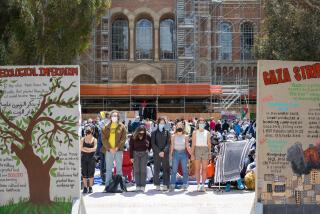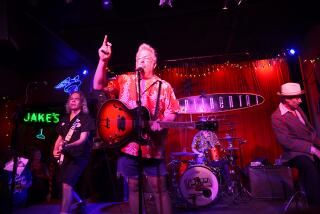Nixon From the Good Side
- Share via
There’s a good chance that if you’re breathing, you have an opinion about Richard Nixon.
Suppose, for a minute, that you had never liked what he stood for. And suppose the Neil Young song “Ohio” came on the radio while you were driving to the Richard Nixon Library & Birthplace in Yorba Linda. (The song tells the story of four Kent State University students being killed when President Nixon ordered the National Guard to break up an anti-war demonstration.)
Then, you would be in quite a lather, as I was, by the time you got to the Nixon museum. This actually happened.
Still, I found the museum fascinating, and its images have stayed with me in the days since my visit--the “Checkers” speech replayed on a 1952-style television, the wedding gowns, Pat Nixon’s grave, the former President’s videotaped reminiscence about coming back from the “valleys” in his career.
This museum is meant to glorify its namesake. Criticism and negativity are largely omitted here. I overheard one woman say, as she was leaving, “This was an eye-opener for me, because I’ve had kind of a negative view.”
Don’t make her mistake. This museum tells one side of the story. But if you look at it through that lens, it can be enjoyed as an emotion-filled ride back through interesting times.
Noon to 2: Entering the museum, you’ll be greeted by a trio of flags: American, Californian and presidential.
Admission is $4.95 for adults, $1 for kids 8 to 11, and $2.95 for people 62 and over. Children under 8 are admitted free.
The entry hall is vast and high-ceilinged. On the left side are a dozen folding chairs set in front of a new video tribute to Pat Nixon, narrated by Jimmy Stewart. It shows film clips of Mrs. Nixon on her trips to various parts of the United States and the world--Peru, Liberia, the Soviet Union.
The tape is almost too sweetly adulatory. But it’s only 10 minutes long.
The right side of the hall contains a fairly interesting display of Nixon’s ancestors, parents and life before he entered politics.
In the center of this main hall are two doors: One leads to a viewing of a 25-minute film of Nixon’s life, the other to the main museum. Which door you enter depends on your timing. A digital clock above the theater tells how many minutes until the film begins again.
At the entry to the main museum, you’ll find a sometimes-whimsical display, “The People’s Presidents: America’s Chief Executives in Portrait, Caricature and Kitsch.” Included are a wooden carving of Gerald Ford skiing, a silhouette portrait of George Bush and a ceramic plate depicting Dwight Eisenhower.
The tale of Nixon’s days in politics begins with the next display, “Road to the Presidency.” Here, Nixon has won a congressional seat as the representative from Whittier.
A display in photos and radio recordings (heard on headphones) tells the tale of Nixon’s first political battle in office: his persistent pursuit of Alger Hiss, who was convicted of perjury for denying he gave State Department documents to the Soviets.
Next is Nixon’s 1950 campaign for the U.S. Senate, and his 1952 run for vice president (the “Checkers” speech is aired here). Nixon’s eight years as vice president are portrayed in a series of photos that show his interest in foreign affairs blossoming.
The section depicting the 1960 presidential campaign is one of the most clever.
Visitors are invited to sit on couches in a mock living room that is decorated in middle-class suburbia from that year. Here, one can view the famous Nixon-Kennedy debates, replayed on a television screen.
Nixon’s presidency is evoked in a room filled with 10 life-size bronze statues of world leaders he met: Mao Tse-tung, Winston Churchill, Golda Meir.
The statues are grouped as though they are chatting. An interactive video display allows visitors to learn more about any one leader.
Next is a watered-down look at the Vietnam War, a pictorial tribute to Pat Nixon, and gowns from the inaugural and Julie Nixon’s wedding to David Eisenhower. The domestic affairs room, lauding Nixon’s contributions in the areas of energy and health, is silent and unimaginative.
Then come the Watergate years, depicted in perhaps the least interesting setting.
The hall is dark, and most of the displays are written--eliminating the interest of videos or photographs. Headphones allow visitors to listen to portions of the infamous Watergate tapes.
A final glass case contains the eight books Nixon has written.
As you leave the building, you will want to wander across the yard to the Nixon birthplace, a modest and neat little home. A rose garden inhabits the ground between the two buildings; Pat Nixon’s small gravestone is there, just beyond the garden.
2 to 3: Yorba Linda has several chain restaurants: Chili’s, Polly’s and Mimi’s, all within walking distance of the museum.
I like the one-of-a-kind Main Street Restaurant because it is so quirky.
It boasts an ability to make a six-foot burrito, and you can order a scaled-down version (for three people) from the menu.
Main Street serves other Mexican dishes and Italian food, too. But burritos are a specialty--there are 19 varieties, wet and dry.
Prices run about $5 to $6 each.
*
1. Richard Nixon Library & Birthplace, 18001 Yorba Linda Blvd., Yorba Linda. Open Monday through Saturday, 10 a.m. to 5 p.m.; Sunday, 11 a.m. to 5 p.m. (714) 993-3393.
2. Main Street Restaurant, 4902 Main St., Yorba Linda. Open Monday through Thursday, 11 a.m. to 9:30 p.m.; Friday and Saturday, 11 a.m. to 10 p.m.; Sunday, 10 a.m. to 9 p.m. (714) 777-9427.
Parking: The library has free, on-site parking. There is on-street parking in front of the restaurant. OCTA bus 26 stops in front.
More to Read
The biggest entertainment stories
Get our big stories about Hollywood, film, television, music, arts, culture and more right in your inbox as soon as they publish.
You may occasionally receive promotional content from the Los Angeles Times.










